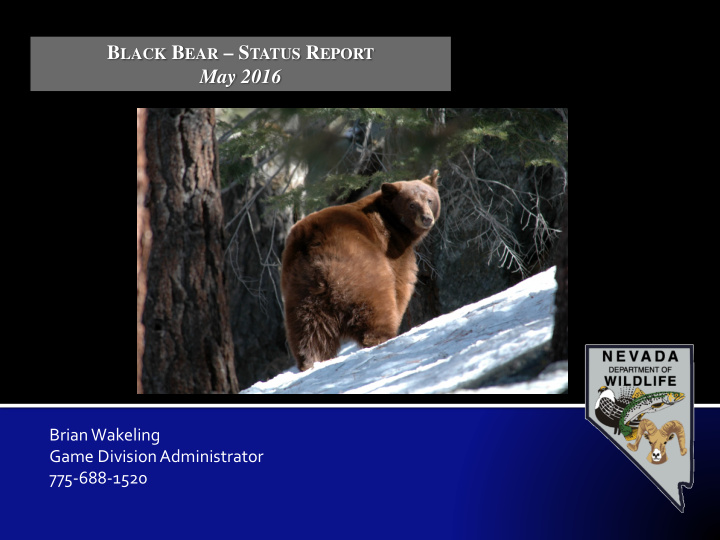



B LACK B EAR – S TATUS R EPORT May 2016 Brian Wakeling Game Division Administrator 775-688-1520
Public safety – 9 Hit by vehicle – 21
H ISTORICAL AND C URRENT R ANGE Original distribution derived from historical articles and pioneer journals Extirpated from states’ interior by early 1900s Recolonization occurring since probably early 1980s Current distribution - those areas containing known viable populations Lackey et al. 2013
H ISTORICAL AND C URRENT R ANGE Original distribution derived from historical articles and pioneer journals Extirpated from states’ interior by early 1900s Recolonization occurring since probably early 1980s Current distribution - those areas containing known viable populations Expansion into historic habitat noted Lackey et al. 2013
Long-Term Black Bear Research – Twentieth Year Data collection since 1997 Management Plan 2012 Two approaches to population assessment Population monitoring Harvest monitoring Sample size of 825 individual bears to date Individually marked 499 bears Deployed >100 radiotelemetry collars Among the most intensively studied populations in the US Cooperative Research with University of Nevada, Reno and Wildlife Conservation Society
P UBLICATIONS AND P RODUCTS • Eight peer refereed manuscripts in professional journals plus three more in draft. • Four population estimates generated • 2002 - 180 ± 117 4 years n = 99 bears • 2008 - 253 ± 27 12 years n = 420 • 2011 - 456 ± 39 15 years n = 532 • 2014 - 445 ± 14 18 years n = 601 500-700 bears in state – current estimate Study area plus surrounding ranges Three internationally recognized experts associated with this work over the 20 year period Jon Beckmann, Joel Berger, and Jim Sedinger
P OPULATION E STIMATES A RE C ONSERVATIVE Results in population models are inherently conservative Heterogeneity in capture probabilities Uncertainty is a given, but it decreases with higher sample sizes Further conservatism built into analysis 337 bears removed from model • dead on first encounter • dependent cubs with no further encounters Current levels of mortality accounted for Estimates based on results from study area which excludes surrounding ranges due to very low sample sizes in those areas
S PECIES M ANAGEMENT P LAN Bear population will be monitored and adaptive management will be applied. Involves analyzing available information and applying a management action followed by a thorough evaluation and adjustment of management programs as needed. Trends in population demographics Mortality data evaluated on a running 3-year average per NDOW Black Bear Management Plan
H ARVEST D ATA TO DATE 2011-2015 2011 2012 2013 2014 2015 3 yr Current Harvest All Years number males 9 10 10 12 8 30 49 number females 5 1 4 6 6 16 22 total killed 14 11 14 18 14 46 71 available tags 45 45 45 45 45 harvest limit 20 20 20 20 20 % females 36% 9% 29% 33% 43% 35% Moderate 31% % adult females ≥5 80% 100% 75% 100% 83% 75% Light 77% in female harvest #females ≥ 5 4 1 1 6 5 Mean age males 5.9 5.1 6.1 7 8.5 7.1 Light 6.6 8.3 Mean age females 6.9 9.0 7.8 10.5 6.5 7.8 Mean age - all 5.9 5.5 6.6 8.2 7.6 7.5 6.9 Male/Female 1.8 10.0 2.5 2.0 1.3 1.9 2.2 34% Success rate 31% 24% 31% 40% 31% 32%
H ARVEST D ATA TO DATE 2011-2015 A DDITIONAL H UNT S TATISTICS 69% used dogs (49 of 71) 15 tagged bears taken 2 citations issued 56 bears pursued and treed but not killed 55% killed in Unit 291 – Pinenuts
P INENUT R ANGE - HARVEST DATA 2011-2015 2011 2012 2013 2014 2015 3 yr Current Harvest All Years number males 4 4 4 8 5 17 25 10 number females 3 0 1 3 6 13 27 total killed 7 4 5 11 11 38 available tags 45 45 45 45 45 harvest limit 20 20 20 20 20 % females 43% 0% 20% 0.3 55% 37% Moderate 34% % adult females ≥5 67% 0% 0% 100% 83% 80% Light 77% in female harvest #females ≥ 5 2 0 0 3 5 Mean age males 6.9 7.0 4.8 5.3 7.4 Light 6.6 Mean age females 5.7 0.0 2.0 7.0 7.0 6.5 6.3 6.8 Mean age - all 6.4 4.8 4.6 7.3 7.3 6.5 Male/Female 1.3 #DIV/0! 4.0 2.7 0.8 1.7 1.9 Success rate 16% 9% 11% 0.2 24% 20% 17%
A PPLICATION S TATISTICS 2011-2016 11,935 total applications (not including bonus point only apps) Applicants representing 36 states and 1 foreign country • > 11,300 Nevada resident applications • 1,230 from Clark County (10% of total apps) • > 600 non-resident applications
P OPULATION S TATISTICS λ > 1 S EDINGER 2014 Population continues to grow but at a slower rate compared to earlier period. Reaching K? Growth in population is representative of both sexes. “I checked for a change in survival following implementation of the hunting season in 2011 and could find no effect.” Dr. James Sedinger – population ecologist, UNR
C ONTINUED M ONITORING AND R ESEARCH Heritage Fund projects Habitat modeling - RSFs Columbia University DNA mapping – immigration & population connectivity University Nevada, Reno Isotope analysis University of Tennessee Tim Torell
41 resident tags, 4 nonresident tags issued Harvest limit set at 20 2,209 resident applications 129 nonresident applications 2 resident tags turned in (no alternatives)
14 bears harvested (6 female, 8 male) Parameter Light Harvest Moderate Harvest Heavy Harvest % Females in Harvest < 30% 30-40% > 40% % Adult Females in Harvest > 55% 45-55% <45% Mean Age of Harvested Males > 4 years 2-4 years <2 years Parameter 2015 3 Year Average % Females in Harvest 43% 35% % Adult Females in Harvest 83% 88% Mean Age of Harvested Males 8.5 7.1
Q UESTIONS ?
Recommend
More recommend